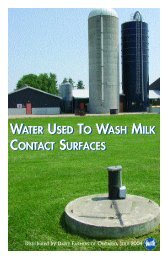Canadian Quality Milk On-Farm Food Safety Program - Centre ...
Canadian Quality Milk On-Farm Food Safety Program - Centre ...
Canadian Quality Milk On-Farm Food Safety Program - Centre ...
You also want an ePaper? Increase the reach of your titles
YUMPU automatically turns print PDFs into web optimized ePapers that Google loves.
<strong>Canadian</strong> <strong>Quality</strong> <strong>Milk</strong><br />
3.2.4.4 Recommended Procedure for Collecting Composite<br />
<strong>Milk</strong> Samples for Culture<br />
1. Label outside of sterile milk sample vials with a waterproof marker.<br />
2. Wash and dry hands ⎯ use disposable gloves.<br />
3. Wash and dry teats as if preparing for milking or pre-dip teats, allowing up to 30<br />
seconds of contact time before drying with individual towels.<br />
4. Discard 2−3 streams of milk from each teat.<br />
5. Scrub each teat end with an alcohol swab. Scrub the teats furthest away from you<br />
first, then the closest teats.<br />
6. Allow a few seconds for the teat ends to dry.<br />
7. Do not touch the inside of the vial or lid. <strong>Milk</strong> one stream from each teat into the vial.<br />
Collect milk from the closest teats first; then collect from the furthest teats.<br />
8. Replace the lid on the vial.<br />
9. Dip teats with an approved dip after collecting the sample.<br />
10. Refrigerate the samples immediately. Check with the lab or your veterinarian to<br />
determine if samples should be frozen rather than refrigerated.<br />
11. Pack milk samples so they remain chilled during transport.<br />
12. Ensure the samples reach the laboratory as quickly as possible.<br />
See Chapter 11 of the Troubleshooting Guide for additional information on<br />
interpreting information about mastitis from individual animals.<br />
3.3 SUMMARY OF HAZARDS AND BEST<br />
MANAGEMENT PRACTICES<br />
HAZARD SOURCE BEST MANAGEMENT PRACTICES<br />
Livestock medicine<br />
and chemical<br />
residues in meat<br />
and milk<br />
Broken needles in<br />
meat<br />
• Any treatments<br />
with livestock<br />
medicines<br />
• Any injectable<br />
treatment of<br />
livestock<br />
medicines<br />
CHEMICAL<br />
Identify all cattle according to National Livestock<br />
Identification (NLID) or Agri-Tracabilité Québec.<br />
Identify all cattle (e.g. ear tag) so that treatment records<br />
can be maintained.<br />
Buy residue-free animals from a reliable source.<br />
PHYSICAL<br />
Buy animals from a reliable source that do not contain<br />
broken needles.<br />
June 2010 3—17
















